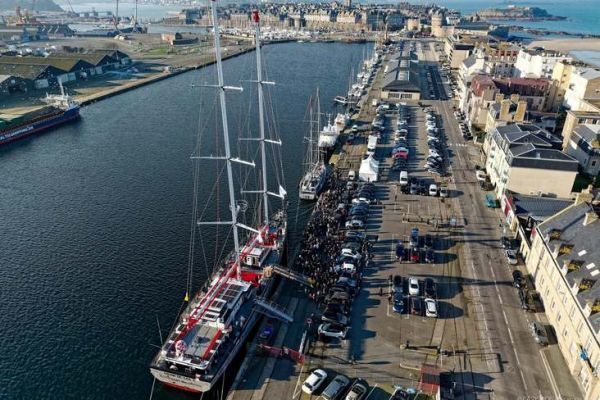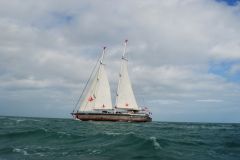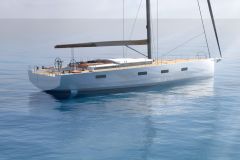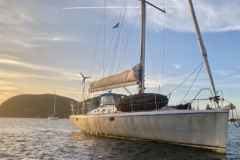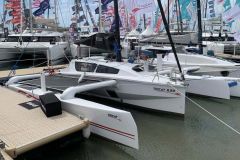Christened on January 11, 2024, Grain de Sail II marks a new stage in the return of sailing cargo ships, with impressive characteristics: 52 m overall length, 10.7 m beam, 1,500 m2 of sail area and 350 T of cargo capacity. We wanted to find out more about this giant, and better understand the differences with our pleasure boats. So, in the company of Gilles Lamiré, who is in charge of the boat's sailmaking, we went aboard for a guided tour.
A simple deck plan despite its excessiveness
On board Grain de Sail II, there are up to 1500 m² of canvas to manage. Yet everything has been designed to be as simple as possible.
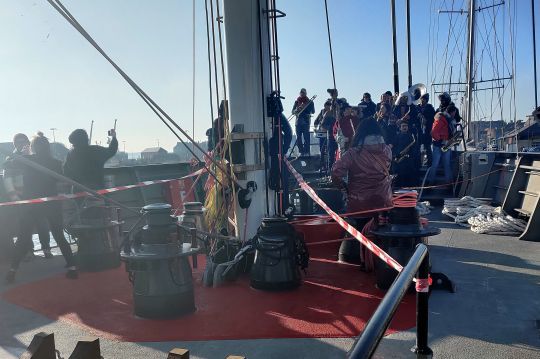
Two huge Harken 11.30 hydraulic winches - with a working load of up to 9t and a power ratio of 86.6:1! - are installed at the foot of each of the two masts. A Harken 80.2 winch on each side is used for the headsails, and that's about it. The sheets and halyards remain on large headstocks, which dispenses with the need for the usual piano. The two single blockers installed on the mast are used for the lazy jack and the man halyard.
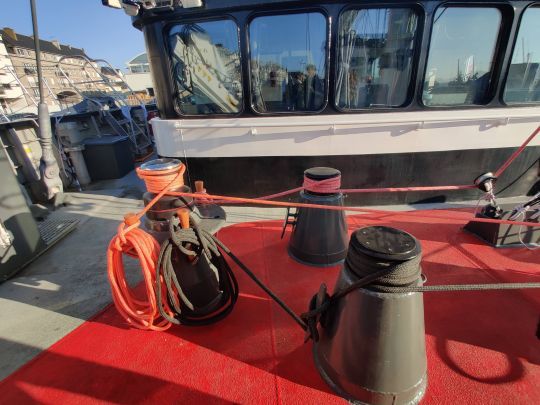
Although sail hoisting and lowering must be performed at the mast foot - it takes 10-15 minutes to hoist a mainsail - sheet trimming can be managed directly from the central wheelhouse.
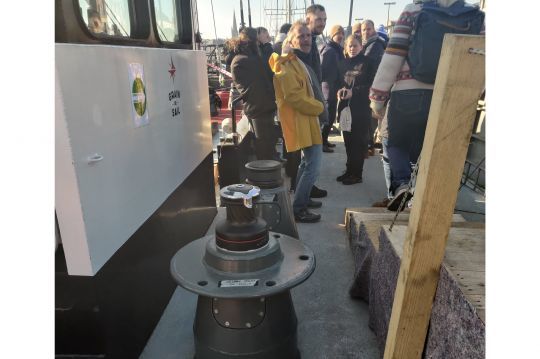
Gilles sums it up simply: "The boat is designed like a sailboat. The dimensions make it impressive, the sail surfaces are impressive, the loads are impressive, but it remains a classic sailboat, with fairly classic maneuvers. "
XXL efforts
But once you've got past the relative ease of use, you can start looking at the details to appreciate the sheer size and forces at play. The masts, made entirely of carbon, weigh 12 and 8 tons, with their stays, and the thickness of the carbon monolith, visible at the bottom of the mast, puts the apparent simplicity into perspective. Gilles explains: "The rig has been sized to 100% righting torque. You can lay the boat down without it dismasting."
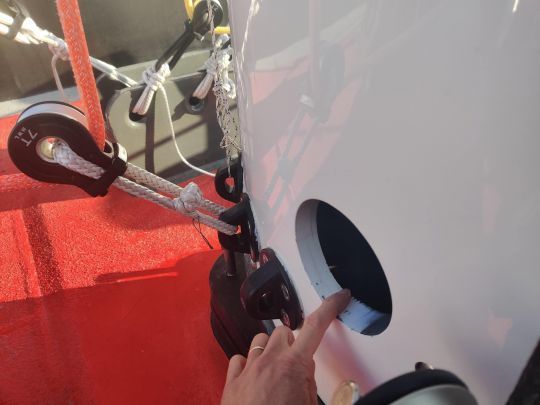
The load in the rigging is measured continuously, and shows 35 T in the shrouds of the foremast and 20 T in those of the mainmast.

Classic sails and fittings, but big ... very big
The entire sail plan is managed as usual on a cruising boat. The mainsails can be furled, and two gangways on either side of each boom allow you to walk along the sails. Upwind sails : J1 (Yankee) and J2 (Trinquette) are set on hydraulic furlers.

The only particularity of this boat, compared to our usual boating habits, is the management of the gennaker. Mounted on a furler, it is then swallowed below deck and stored rolled up on a drum, similar to a fishing net furler.
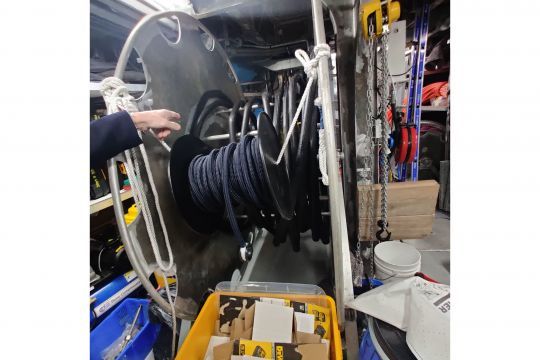
The 350 tons of cargo ensure the stability of this sailing freighter. When the boat sails light without its cargo, ballast tanks take over, as is the case on conventional cargo ships. In accordance with merchant ship regulations, the water in these ballast tanks is filtered and purified, so as not to contaminate the area in which the water is discharged with organisms taken from a different part of the globe.
A layout designed for life at sea
Life on board is organized at the stern of the ship, on 3 levels. At the very top, a second wheelhouse - used for port maneuvers - gives access to a cockpit for the crew: a terrace that sailors can use to get some fresh air and enjoy the outdoors.
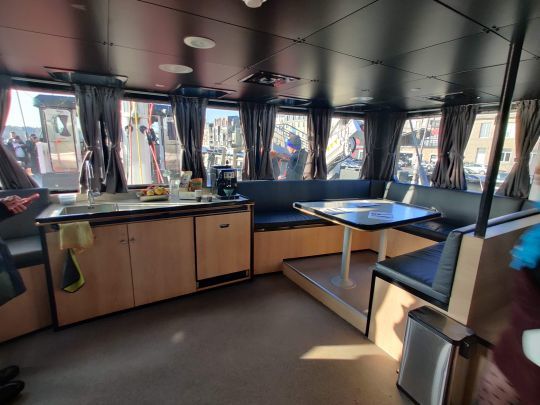
One level down, accessible via a steep staircase, is the saloon: a resting and dining area. The galley is on the same level as this main deck area.
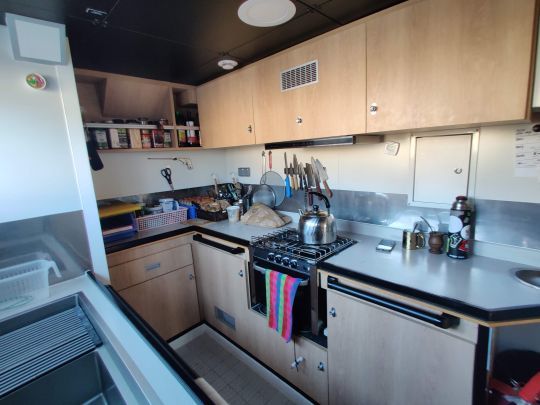
To access the cabins and bathrooms, you have to go down again and pass through a watertight door with an overhang of almost 60cm, as required by cargo regulations. The rest of the interior space is dedicated to the various systems and engines, and of course to the cargo.
This cargo, mainly made up of fragile cocoa and coffee, is treated with the utmost care. Stored on pallets, it is held in place by inflated balloons. No straps to damage the precious beans. A ventilation system ensures that air humidity and salinity are always optimal.
Every 6 hours, a crewman will make a round of the hold to confirm that all is well.
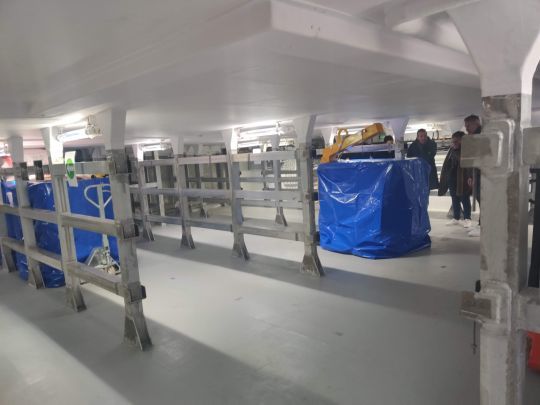
8 people aboard a 52m sailing yacht
Yann Jourdan, the boat's captain, tells us what life is like for the 8 crew members on board: 1 captain, 1 lieutenant, 1 chief mate, 1 deckhand, 2 deckhands, 1 cook and 1 chief engineer.
He begins by pointing out that the day on board the ship is closer to the merchant navy model than to that of a yachtsman. The 4-hour shifts run from noon to noon, and begin with a briefing on the next 24 hours: weather, safety, upcoming exercises and any special work to be carried out. Staff starting their shift at midday have to have lunch just before their shift begins, while those finishing their shift can eat immediately afterwards. The same applies in the evening, with two services scheduled for 7.30pm and 8pm.
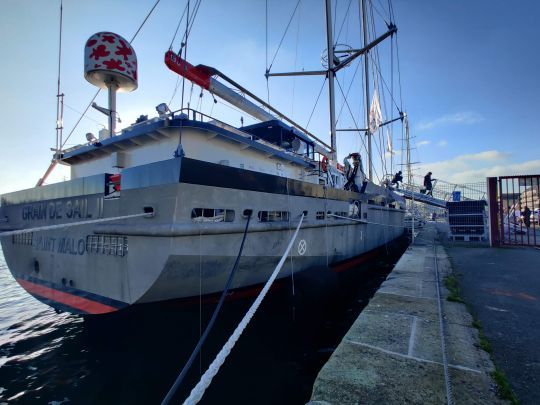
During his watch, the watch leader must maintain a constant watch, and therefore be close to the radio and radar in the wheelhouse. The deckhand's tasks include trimming the sails, making rounds, miscellaneous work and "housekeeping" duties, which are defined in advance and rotate on a weekly basis. It should be pointed out that household and hygiene tasks are the responsibility of the entire crew, including the captain.
Manoeuvres are anticipated so that they can be carried out between watches, when all the crew are on deck," explains the captain: "In the North Atlantic, it's possible to anticipate oversailing, unlike in the Mediterranean, where the wind can strengthen without warning. So we anticipate the need to reduce sail. If, however, we get caught, we make a run for it just long enough to wake up and get the whole crew on board" .
Grain de Sail II in figures
- Overall length: 52 m
- Overall width: 10.70 m
- Mainmast height: 48m
- Mainsail height: 44m
- Upwind sail area : 1170m²
- Downwind sail area: 1500m²
- Mainsail: 370m
- Mainsail: 340m²
- Yankee : nc
- Trinquette: nc
- Tourmentin: 70m² surface area
- Code 0: 500m² (500 sq. ft.)
- Light displacement: 300t
- Loaded displacement: 650t (240 US/294 EU pallets)



